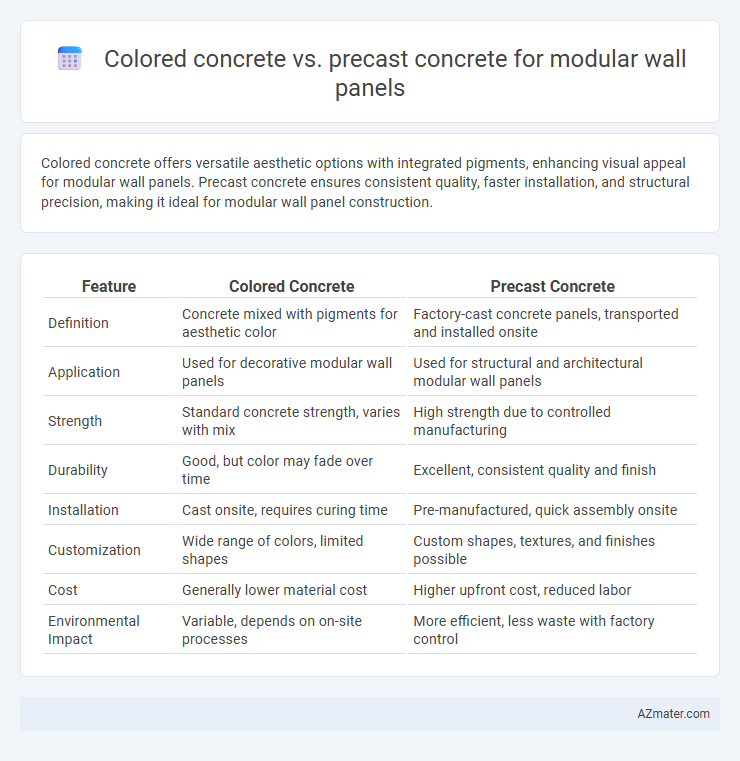Colored concrete offers versatile aesthetic options with integrated pigments, enhancing visual appeal for modular wall panels. Precast concrete ensures consistent quality, faster installation, and structural precision, making it ideal for modular wall panel construction.
Table of Comparison
| Feature | Colored Concrete | Precast Concrete |
|---|---|---|
| Definition | Concrete mixed with pigments for aesthetic color | Factory-cast concrete panels, transported and installed onsite |
| Application | Used for decorative modular wall panels | Used for structural and architectural modular wall panels |
| Strength | Standard concrete strength, varies with mix | High strength due to controlled manufacturing |
| Durability | Good, but color may fade over time | Excellent, consistent quality and finish |
| Installation | Cast onsite, requires curing time | Pre-manufactured, quick assembly onsite |
| Customization | Wide range of colors, limited shapes | Custom shapes, textures, and finishes possible |
| Cost | Generally lower material cost | Higher upfront cost, reduced labor |
| Environmental Impact | Variable, depends on on-site processes | More efficient, less waste with factory control |
Introduction to Colored Concrete and Precast Concrete
Colored concrete integrates pigments directly into the concrete mix, offering customizable aesthetic options for modular wall panels with durable, fade-resistant finishes. Precast concrete involves casting the panels in a controlled factory setting, ensuring high-quality, uniform dimensions and accelerated installation times on-site. Both methods enhance modular wall panel construction by combining structural integrity with design flexibility for diverse architectural applications.
Key Differences Between Colored Concrete and Precast Concrete
Colored concrete integrates pigments directly into the concrete mix, allowing for customizable hues and aesthetic variety ideal for decorative modular wall panels. Precast concrete involves casting panels in controlled factory settings, emphasizing uniformity, strength, and rapid on-site installation. While colored concrete prioritizes visual appeal and color consistency, precast concrete excels in structural integrity and production efficiency for modular wall panel applications.
Aesthetic Options: Color and Texture Variety
Colored concrete offers a wide range of vibrant pigments that can be fully integrated into the mix, providing long-lasting, uniform color throughout the modular wall panels. Precast concrete panels allow for surface treatments such as stains, coatings, and decorative molds that create diverse textures and patterns, enhancing aesthetic customization. Both methods enable architects to achieve tailored design visions, but colored concrete excels in consistent coloration while precast concrete stands out in texture versatility.
Strength and Durability Comparison
Colored concrete for modular wall panels offers enhanced aesthetic customization while maintaining high compressive strength, typically ranging from 4,000 to 6,000 psi. Precast concrete panels exhibit superior structural integrity due to controlled manufacturing conditions, often achieving compressive strengths above 6,000 psi and greater durability through reduced permeability and better curing processes. The durability of precast concrete is further enhanced by its resistance to freeze-thaw cycles and chemical attacks, making it more suitable for long-term exterior applications compared to colored concrete.
Installation Process: On-site vs Off-site Construction
Colored concrete for modular wall panels requires an on-site installation process that allows for customization and adjustments during casting, enhancing color consistency and design flexibility. Precast concrete panels are manufactured off-site in controlled environments, enabling precise quality control and faster installation times when transported to the construction site. The off-site production of precast concrete reduces on-site labor and weather-related delays, making it a more efficient choice for large-scale modular wall panel projects.
Cost Implications: Materials and Labor
Colored concrete for modular wall panels typically incurs higher material costs due to pigments or dyes, but it can reduce labor expenses by enabling onsite casting and faster installation. Precast concrete panels demand significant upfront investment for factory production and specialized molds, increasing material and fabrication costs, yet benefit from decreased onsite labor and quicker assembly. Overall, colored concrete offers flexibility with moderate cost variations, while precast concrete involves higher initial costs offset by streamlined labor during installation.
Maintenance Requirements and Longevity
Colored concrete for modular wall panels offers enhanced aesthetic longevity with minimal maintenance, as its pigmentation permeates the material, reducing the need for repainting or surface treatments. Precast concrete panels provide superior durability and consistent quality due to factory-controlled conditions, requiring periodic inspections for joints and sealants to prevent water infiltration and freeze-thaw damage. Both materials exhibit strong resistance to environmental wear, but precast concrete typically delivers greater structural longevity when maintained properly.
Environmental Impact and Sustainability
Colored concrete for modular wall panels reduces environmental impact by incorporating recycled pigments and minimizing the need for additional surface coatings, enhancing durability and lowering maintenance requirements. Precast concrete panels often enable more efficient resource use through controlled factory production, reducing waste and energy consumption compared to onsite casting. Both methods support sustainability by optimizing material usage and enabling thermal mass benefits, but colored concrete's integration of recycled materials offers a distinct advantage in reducing carbon footprint.
Applications in Modular Wall Panel Systems
Colored concrete offers versatile design options and aesthetic customization for modular wall panel systems, making it ideal for architectural facades and decorative panels in commercial and residential buildings. Precast concrete provides superior structural integrity and precise manufacturing tolerances, suited for load-bearing modular wall panels in industrial and infrastructure projects. Selecting between colored concrete and precast concrete depends on balancing visual appeal with performance requirements in modular wall panel applications.
Choosing the Right Solution for Your Project
Colored concrete offers versatile aesthetic options and seamless integration for modular wall panels, enhancing design flexibility with pigmented mixes that resist fading. Precast concrete delivers superior quality control, faster installation, and consistent structural performance due to factory production in controlled environments. Selecting between colored and precast concrete depends on project priorities such as desired finish customization, timeline constraints, and budget considerations for optimizing modular wall panel outcomes.

Infographic: Colored concrete vs Precast concrete for Modular wall panel
 azmater.com
azmater.com